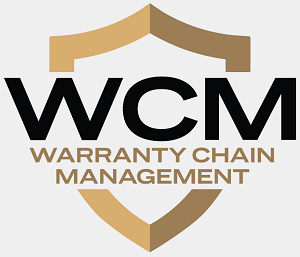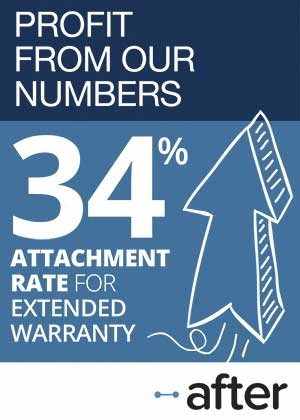Apple's Warranties & Service Contracts: Not only has the company grown into one of the world's largest product warranty providers, but it's also running one of the world's largest extended warranty programs. However, while iPhone sales were down by 12% in 2016, iPhone protection plan sales were down by even more. Is it the competition? Or are consumers buying fewer iPhone extended warranties from Apple?
Thanks to the success of the iPhone, Apple Inc. has become not only one of the world's largest warranty providers, but also one of the world's largest extended warranty providers. But in the fiscal year just recently concluded, both product sales and the sale of protection plans declined significantly.
The sources of our financial figures are Apple's financial reports and our own twisted theories about warranties and service contracts. The company ends its financial year at the end of September, so that complicates some of our calculations, because the product warranty data is collected quarterly while the service contract data is collected annually.
Let's start with the product warranty data. Apple offers a one-year warranty on most of its hardware, though in some countries, local laws require manufacturers to guarantee their products for at least a two-year period. But that doesn't complicate our work, because Apple itself reveals its annual spending on product warranties, adjusted for both local currencies and local laws.
Product Warranty Expenses
In the year ended September 24, 2016, Apple set aside $3.585 billion in warranty accruals and spent $4.663 billion on warranty claims, causing its warranty reserve fund balance to shrink from $4.780 billion to $3.702 billion.
Warranty spending in the previous fiscal year consisted of $5.0 billion in accruals made and $4.4 billion in claims paid. So while the amount the company is setting aside for warranty expenses is declining, the amount it is actually spending is rising. And that has caused the warranty reserve balance to contract by more than a billion dollars.
The company also provides quarterly updates throughout the fiscal year. And by adding together the claims and accruals reported in the first, second, and third fiscal quarters (covering the months of October to June), and by subtracting them from the annual figures, we can calculate the claims and accruals just for the fourth quarter.
Using this system, with figures going back to 2003, we have assembled a series of 55 quarterly measurements of the amount of claims paid and accruals made by Apple. Figure 1 includes the claims figures, while Figure 2 contains the accrual figures.
Figure 1
Apple's Product Warranties
Claims Paid per Quarter, 2003 to 2016
(in Millions of U.S. Dollars)
Note that claims payments hit their peak in the second half of calendar 2015 (corresponding to Apple's fourth and first fiscal quarters). Those are the only instances when Apple paid $1.25 billion or more during a single quarter (equivalent to more than half a million dollars an hour). During the same time period, GM and Ford were paying well under a billion dollars per quarter, HP Inc. was paying around $300 million per quarter, Caterpillar and Deere were paying around $200 million per quarter, and only Volkswagen AG was paying more than Apple in claims.
All of these figures are worldwide. Neither Apple nor any other companies provide country-by-country breakdowns of their warranty expenses, nor do they identify warranty spending by division or by product line. But they do generally provide geographic breakdowns for total revenue. For instance, Apple said that roughly 35% of its total revenue last year came from the U.S., slightly more than the percentage reported in fiscal 2015.
Does this mean 35% of its warranty expenses came from the U.S. as well? It might, though the cost of parts, labor, and taxes in other markets might impact that ratio, as will the cost of the longer warranties required in Australia, Europe, and elsewhere.
Warranty Accruals
Apple's warranty accruals have exceeded $1.25 billion per quarter seven times since the beginning of fiscal 2013, most recently in the quarter that included the months of October, November, and December 2015. That represents the first quarter of Apple's fiscal year, and also corresponds to the year-ending holiday season.
We note that because, as can be seen in Figure 2 below, the three highest quarters have been the last three first quarters of their fiscal year, with the months of October to December 2014 being the highest of all. Meanwhile, the months of April to June 2016, with only $380 million in accruals, represented the lowest quarterly total since the spring of 2012.
Figure 2
Apple's Product Warranties
Accruals Made per Quarter, 2003 to 2016
(in Millions of U.S. Dollars)
The amount of warranty accruals a company makes is dependent upon its own expectations for future warranty costs, which in turn is dependent on product sales and projected changes in the reliability and repair or replacement cost of those products. In contrast, the amount of claims paid is simply the size of the actual bills paid. So there is rarely a one-to-one correspondence between the two amounts, even when time-shifting them to account for the lag between when a product is sold and when it comes back for warranty work.
However, over the longer term, especially when most of a company's product warranties expire after a year, the amount going into and coming out of the warranty reserve is likely to equalize, or else the ending balance in the fund will soar or plummet. For Apple, the balance soared to well over $5 billion in fiscal 2015, before plummeting in the past fiscal year. That's because, as was previously mentioned, claims have exceeded accruals in recent quarters.
Extended Warranty Revenue
Now let's try to get a handle on Apple's extended warranty revenue. The AppleCare Protection Plans cover malfunctions and defects in Macintosh computers, while the AppleCare+ Protection Plans, for the iPhone, iPad, iPod, and Apple Watch, also include accidental damage protection. All have a duration of two years from the date of purchase, which means they overlap the product warranty for some (or in certain countries, for all) of their lifespan.
The company does not disclose sales figures for AppleCare service contracts. AppleCare Protection Plans for the Macintosh family are sold in most countries. AppleCare+ Protection Plans, which include accidental damage protection, are sold for the iPhone and iPad in the U.S., Canada, Mexico, and Puerto Rico, in nine European countries, and in Australia, China, Hong Kong, Japan, Macau, New Zealand, Singapore, and the U.A.E.
In the U.S., AppleCare plans are priced at $99 for the Mac mini; $169 for the iMac, $249 for the MacBook; and $349 for the 15-inch MacBook Pro. AppleCare+ plans are $49 to $99 for the Apple Watch; $59 for the iPod Touch; $99 for the iPhone SE and iPad; and $129 for the iPhone 6 and 7. International prices are comparable.
Because Apple itself is selling the break/fix coverage, it retains the risk, and works with units of the American International Group Inc. to cover the cost of accidental damage claims. This is very important, because under U.S. accounting rules, this forces Apple to carry the amount of service contract sales as deferred revenue on its books, until that revenue is recognized.
What this means is that when an AppleCare service contract is sold, the revenue is immediately deferred and is then recognized gradually, at a rate of one-eighth of the total per quarter, until it's all recognized when the service contract expires at the end of its two-year term. And that, in turn, means that when a service contract is sold, half the deferred revenue goes onto the books as a current liability (payable in one year or less) and half goes on the books as a non-current liability (payable in one year or more).
Unfortunately, Apple combines its deferred revenue from AppleCare with deferred revenue from other sources, such as gift cards. So there is no clear figure provided just for extended warranty revenue.
Gift cards must always be classified as a current liability, because they can be used at any time -- now, tomorrow, next year, or never. We should add that nobody on the staff here has an accounting degree or any bookkeeping training whatsoever, so this explanation is far away from any understanding of Generally Accepted Accounting Principles.
Non-Current Deferred Revenue
But let's do some ninth grade algebra, shall we? If X is the amount of AppleCare revenue, Y is the amount of gift card revenue, and half of X is current while all of Y is current, then what is X equal to? To solve that problem, we need to know the amount of non-current deferred revenue, which is also equal to half of X. Or to put it in simpler terms, at any given point in time, the size of Apple's extended warranty program is approximately twice as large as its non-current deferred revenue.
And indeed, that figure is included in Apple's balance sheet. The non-current deferred revenue total was $2.930 billion on Sept. 24, 2016, down from $3.624 billion on Sept. 26, 2015. Our ninth grade math tells us that this means AppleCare was a $7.3 billion program in fiscal 2015, and a $5.9 billion program in fiscal 2016.
We've separated the service contract and gift card revenue in Figure 3 below. Unlike Figures 1 and 2, this chart follows the Apple fiscal years rather than the quarters of the calendar year. Note that while our estimates suggest that gift card sales have declined very slightly during each of the past two fiscal years, we calculate that AppleCare sales declined by about 19% in fiscal 2016 after peaking in fiscal 2015.
Figure 3
Apple's Extended Warranties:
Service Contracts vs. Gift Cards Sales
in Fiscal Years 2003 to 2016
(in Millions of U.S. Dollars)
This is astonishing. Everyone knows that iPhone sales revenue is also now declining. But it was down only 12% in fiscal 2016. Mac sales were down only 10%. Total revenue was down only 8%. Yet by our calculations, AppleCare sales were down by 19%. That means either contract prices have fallen, or the number of contracts sold per product has fallen. And if it's the latter, then somebody else could be picking up market share at Apple's expense.
Is it going to retailers like Best Buy and Target? Is it going to direct sales programs like SquareTrade and ProtectCell? Is it going to phone companies like Verizon and AT&T? Or are more consumers simply choosing to go without protection plans this year? We haven't seen anything persuasive either way. But it does seem by our estimates that Apple's extended warranty attachment rate is declining faster than sales of hardware.
The decline can be seen in Figure 4, which tracks the claims from Figure 1, the accruals from Figure 2, and the AppleCare sales estimates from Figure 3, but as a percentage of overall product revenue rather than in dollars alone. It's important to subtract out non-hardware revenue sources such as iTunes, because as good as the music is, it doesn't come with a product warranty. Likewise, neither gift cards nor extended warranties come with product warranties, so those sources of service revenue have to be subtracted as well.
Figure 4
Apple's Protection Plans:
Claims Paid, Accruals Made & AppleCare Sales
as a Percentage of Product Revenue, 2003 to 2016
What's clear in Figure 4 is that while Apple's product warranty expense rates were generally low from 2003 to the middle of 2012, they've been much higher since then (except for that big accrual decline in the spring of 2016). And while AppleCare sales were a relatively high percentage of revenue from 2003 to the middle of 2010, they've been much lower since.
At the end of fiscal year 2016, Apple's claims rate was 2.4%. Its accrual rate was 1.9%. And AppleCare sales, by our estimate, were equivalent to 3.3% of product revenue. That AppleCare estimate was down from 3.6% at the end of fiscal 2015 and 3.7% in fiscal 2014. And it was at the lower bounds of the 3%-to-4% range it's been in for the last seven fiscal years. Again, that's astonishing.
International Sales
As long as we're violating GAAP, let's also go ahead and disregard International Financial Reporting Standards as well. As we noted, 35% of Apple's sales are made in the U.S., which our ninth grade algebra tells us means that 65% are made internationally.
But there's a problem: some of those international sales are undoubtedly made in countries where AppleCare+ plans for the iPhone are not for sale, but AppleCare plans for the Mac are available. And we don't know what the attachment rates might be in any of the 20 other countries where AppleCare plans actually are for sale. Therefore, there's no way for us to conclude that 65% of AppleCare and AppleCare+ sales are made outside the U.S. just because 65% of product sales are.
So what we're doing below is essentially multiplying our assumptions together to get additional assumptions. That is not good science. However, it is the holiday season, and if people can believe that flying reindeer can propel an elderly gentleman bearing gifts on a sled, why can't they believe in magical accounting principles?
Let's suspend disbelief and assume that AppleCare and AppleCare+ sales follow the geography of product sales. In Figure 5, we're taking the AppleCare figures from above and multiplying them by the U.S. and international sales figures taken from Apple's annual reports to calculate how much is sold in just the U.S. And by that reckoning, fiscal 2012 was the best year for U.S. sales of AppleCare protection plans, followed closely by fiscal 2015. Fiscal 2016, meanwhile, was the slowest year for U.S. AppleCare sales since fiscal 2013, our estimates suggest.
Figure 5
Apple's Extended Warranties:
AppleCare US Sales vs. International Sales
in Fiscal Years 2003 to 2016
(in Millions of U.S. Dollars)
There's one major flaw with these estimates, however. The 21 countries in which AppleCare+ plans are sold account for only 55% of the world's GDP. AppleCare+ Protection Plans are not sold in India, Russia, or Brazil, just to name a few. Surely some iPhones are sold there. So if we assume that product sales are made worldwide, then as much as 45% of the units might be sold in countries in which AppleCare+ plans are not available. And while U.S. sales account for 35% of Apple's product revenue, the U.S. accounts for only 16% of the world's GDP. So the calculations in Figure 5 could be way off.
AppleCare+ Sales in the U.S.
Still, let's make one more magical accounting assumption: AppleCare and AppleCare+ plans sell just as well for every product the company makes. In other words, if we know the product mix, we can convince ourselves that we also know the protection plan mix. That's totally untrue, and is probably on par with beliefs that an overweight gentleman and his reindeer can land a sled on a roof in the dark. But just this one time, let's believe in magic.
In Figure 6, we've taken the annual sales reports for Apple products and charted them as a percent of the company's worldwide total. The iPhone first went on sale in 2007, when 55% of Apple's product sales revenue came from the Mac family and 44% came from the iPod. The iPad went on sale in 2010, when 45% of Apple's product sales came from the iPhone and 31% came from the Mac family. And so on.
Figure 6
Apple's Product Mix
Percentage of Revenue, 2003 to 2016
By fiscal 2016, the iPhone and iPad together accounted for 87% of Apple's worldwide product sales, meaning that the vast majority of AppleCare revenue also probably came from these product lines. Meanwhile, the Mac family, which accounted for 93% of sales in fiscal 2003, was down to 13% by this year.
Let's make one more magical assumption: that U.S. sales of protection plans have followed the same pattern as worldwide product sales. In Figure 7, we've taken the U.S. portion of the worldwide AppleCare revenue calculated in Figure 5 and multiplied it by the revenue distribution pattern seen in Figure 6.
Figure 7
Apple's Extended Warranties:
AppleCare US for iPhone & iPad vs. Mac & Other Products
in Fiscal Years 2003 to 2016
(in Millions of U.S. Dollars)
If these estimates are correct (and they're probably not), then U.S. total for all AppleCare sales in fiscal 2016 was just over $2 billion, and U.S. sales of just AppleCare+ plans for the iPhone and iPad were probably a bit under $1.8 billion. In fiscal 2015, the respective figures were $2.5 billion and $2.2 billion. So there's been a decline in U.S. sales of both.
The World's Largest?
Still, despite the recent revenue decline, we don't know of a larger U.S.-based service contract program. Even if you combine all the administrators that work with Assurant Solutions and The Warranty Group on vehicle service contracts, neither company has broken the $2 billion annual premium level in the U.S. Neither Best Buy nor Walmart have either.
It could be even bigger. As was mentioned, while the U.S. accounts for 35% of Apple's sales, it accounts for only 16% of the world's GDP. So the iPhone is overachieving domestically, selling at a higher rate within the U.S. than outside of it. And AppleCare+ is not available in every country in which the iPhone is sold.
Therefore, in order to get to the size of the worldwide AppleCare program ($5.9 billion in fiscal 2016, down from $7.25 billion in fiscal 2015), far more than 35% of those premiums must have been paid by U.S. consumers. Those other 20 countries where AppleCare+ is sold account for only 40% of the world's GDP, not 65%. So as much as 25% of iPhone sales may happen in countries where AppleCare+ Protection Plans are not sold. And the world's largest service contract program may be even larger in the U.S. than we think it is.
| 
















